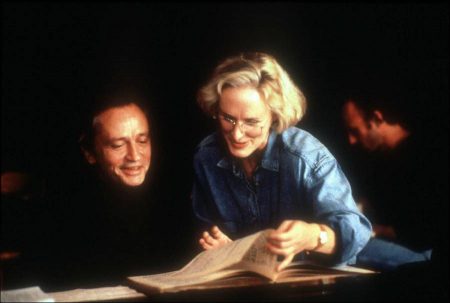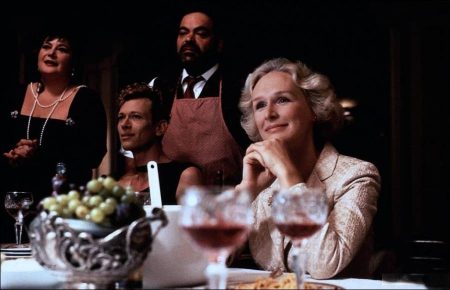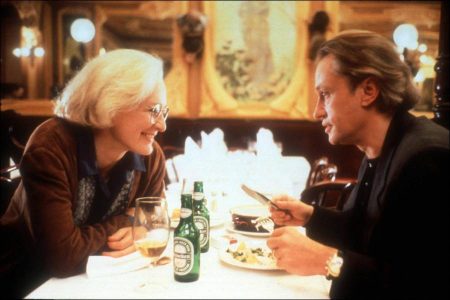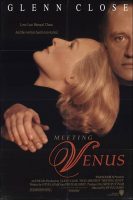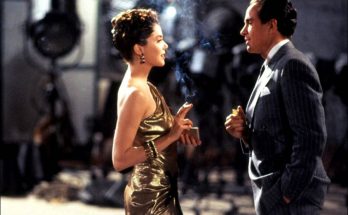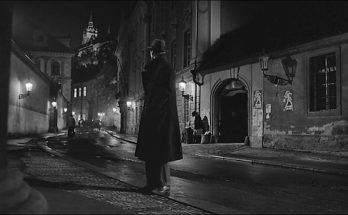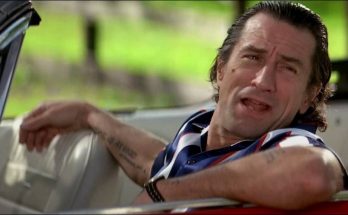Meeting Venus is based on a play cowritten by the film’s director, Istvan Szabo. Glenn Close plays a celebrated Swedish opera star Karin Anderson who is slated to appear in an internationally-telecast production of Tannhauser. Ms. Anderson balks at the notion of working with obscure Hungarian conductor Zoltan Szanto. The much-anticipated production may never get off the ground, thanks to labor-management difficulties, intramural jealousies, and clashing egos.
Admidst all this chaos, the mismatched Anderson and Szanto fall in love. Filmed in Budapest, Meeting Venus was far from a box-office hit thanks in great part to an inadequate advertising campaign; hopefully it will gain the wide audience it deserves on videocassette. (PS: Glenn Close’s singing is dubbed by real-life opera luminary Kiri Te Kanawa. We tell you this because the lyp-synching is done so well that you might actually believe that Close is performing those arias herself).
Meeting Venus is a 1991 British–American-Japanese film directed by the Hungarian director István Szabó and starring Glenn Close, Niels Arestrup, Waltraud Meier, René Kollo, Renate Spingler, Matthias Hölle, Kim Begley, Robin Leggate, Rodney Macann, Roderick Earle, Marián Labuda and Maïté Nahyr. The movie was filmed in Budapest, Hungary.
Many of the characters in this movie have the same name and family name as director István Szabó, but in different languages. The Hungarian name István in English corresponds with Stephen. Surname Szabó means “tailor”. And some persons in film are: Stephen Taylor (English), Stefan Schneider (German), Stefano Sarto (Italian), Etienne Tailleur (French)/ There are also Maria Krawiecki (from the Polish word krawiec which means tailor) and Isaac Partnoi (from Russian word портной [portnoy] = tailor”).
Film Review for Meeting Venus
As the new Europe edges uncertainly toward its future, the parts uneasily eye the whole. There are not only the obvious problems of language and culture, but also ideas about work and love and art.
“Meeting Venus” uses an international opera production as a way of showing them all in collision. The story takes place in Paris, where a new production of “Tannheuser” is contemplated. The conductor (Niels Arestrup) is from Hungary. The diva (Glenn Close) is a temperamental superstar from Sweden. The baritone is a rotund East German who thinks mostly about obtaining hard currency to use in his auto-painting business. When his voice fails, his substitute is an insipid American who is constantly reminded of how things were done differently, and better, in previous productions he has been involved in.
And then there are, of course, the musicians, and the members of the chorus, and the stagehands and electricians and painters and property masters, all members of unions that are ferociously protective of their contracts. And in the front office, management tries to keep everyone happy by taking no clear position on anything.
I imagine that if grand opera were really like this, there would not be any of it. On the other hand, productions and whole seasons are lost because of labor disputes, and the realism of “Meeting Venus” begins to shade over into the satire of “This Is Spinal Tap” in the sequence where the right union man cannot be found to press the button to raise the curtain.
The position of the Hungarian conductor must have been inspired in some ways by the position of this film’s director, Istvan Szabo. He is the leading contemporary Hungarian director (with credits such as the superb “Mephisto”), but now, with the collapse of state subsidies and the opening of Eastern Europe, he, like his character, must learn (in the words of Robert Altman) to fiddle on the corner where the quarters are.
In the film, the director tries vainly to keep everybody happy all of the time, and finds that his duties apparently include an affair with Glenn Close, who is quite sincere and actually very touching during their sweet little love affair, although eventually he, and we, begin to speculate that this is not the first time this diva has gone to bed with her conductor.
There are dozens of major and minor characters in the film, and Szabo juggles them artfully, telling some of their stories and transient flirtations in asides and background action. Meanwhile, the conductor, who is married, finds himself back in Budapest with his wife and his new mistress both at the same time, and the messiness of reality begins to interfere with the unreal backstage world of the opera.
The music in the film is of a high level (Close is dubbed by Kiri Te Kanawa), but there is not very much of it, and indeed we see little of “Tannheuser.” That isn’t the point. The point may be that opera, with all of its romance and coincidence, cannot approach the absurdity of life. Or it may be that through art Europe must find its common destiny. If that is so, Szabo seems to argue, it will not be an easy task.
Meeting Venus (1991)
Directed by: István Szabó
Starring: Glenn Close, Niels Arestrup, Waltraud Meier, René Kollo, Renate Spingler, Matthias Hölle, Kim Begley, Robin Leggate, Rodney Macann, Roderick Earle, Marián Labuda, Maïté Nahyr
Screenplay by: István Szabó, Michael Hirst
Production Design by: Attila Kovács
Cinematography by: Lajos Koltai
Film Editing by: Jim Clark
Costume Design by: Catherine Leterrier
MPAA Rating: PG-13
Distributed by: Warner Bros. Pictures
Release Date: November 15, 1991
Visits: 76
